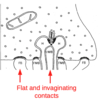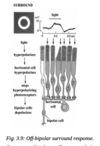Vision L3 Flashcards
is the retina a thin neural sheet?
yep
The retina is a thin neural sheet which, in addition to the photoreceptors themselves, contains four major classes of interneurons:
what are they?
bipolar cells (BC),
horizontal cells (HC),
amacrine cells (AC) and
ganglion cells (GC)
There are also glial elements known as …
(retina sheet)
There are also glial elements known as Müller cells (MC).
terina has _ well defined layers
5 layers
These cells are distributed in five well-defined layers, which can be subdivided into three ____ layers (containing cell bodies) and two _____ layers (containing axons and cell processes).
These cells are distributed in five well-defined layers, which can be subdivided into three nuclear layers (containing cell bodies) and two plexiform layers (containing axons and cell processes).


descibe the outer uclear layer
photoreceptor cell bodies
describe the Outer plexiform layer (OPL
synapses between photoreceptors, bipolars and horizontal cells.
describe the Inner nuclear layer (INL)
bipolar, horizontal and amacrine cell bodies
describe the Inner plexiform layer (IPL)
synapses between bipolar, amacrine and ganglion cells.
describe the Ganglion cell layer (GCL)
cell bodies of ganglion cells.
describe the direct pathway of information flow in the retina
which neurotransmitter do they use?
The direct pathway of information flow is from photoreceptors to bipolar cells (IB/FB) to ganglion cells (G).
All of these cells use glutamate as neurotransmitter.
describe lateral inhibition
Lateral inhibition is mediated by horizontal cells (H) which are GABA-ergic.
Amacrine cells (A) mediate a diverse collection of interactions in the inner retina, and use many different transmitters.
Photoreceptors synapse only with _____ cells and -_____ cells;
Photoreceptors synapse only with bipolar cells and horizontal cells;
ganglion cells receive input from _____ and ______ cells.
ganglion cells receive input from bipolar and amacrine cells.
The output of the retina is carried by the axons of ganglion cells, which together form the _____ nerve.
The output of the retina is carried by the axons of ganglion cells, which together form the optic nerve.
Synaptic processing is characterised by both
____ and _____- of signals
Synaptic processing is characterised by both
convergence and divergence of signals
Ganglion cell axons are the ONLY output (together forming the optic nerve).
is there any input into the retina?
Ganglion cell axons are the ONLY output (together forming the optic nerve).
No efferent input to retina
Apart from ______ cells, all use ______ potentials
Apart from ganglion cells, all use graded potentials
which retinal cells use APs
ganglion cells
amacrine cells usually only fire spikes in response to _____ stimuli.
amacrine cells usually only fire spikes in response to strong stimuli.
why are graded potentials used in the retina?
Graded potentials are a more efficient means of
transmitting information over short distances.
Overall, the retina exhibits ________, possessing 6 million cones, 120 million rods, but only 1.5 million ganglion cells
Overall, the retina exhibits convergence, possessing 6 million cones, 120 million rods, but only 1.5 million ganglion cells
is divergence even across the retina?
the retina does not sample and process visual information uniformly.
The highest resolution is achieved only in foveal regions where there are ~3x more ganglion cells than cones (net divergence); but in peripheral retina there is only one ganglion cell for every ~16 cones (net convergence and loss of spatial information).
describe photoreceptro synapses?
Photoreceptor synapses have a characteristic presynaptic ribbon: a modified presynaptic density characteristic of synapses that transmit graded signals. The postsynaptic targets always include processes from both bipolar and horizontal cells, leading to the term synaptic triad.

describe the cone pedicle?
Cone terminals end in a large synaptic swelling - the cone pedicle. There may be up to 30 synapses at each cone pedicle, reflecting divergence of the cone signal to numerous bipolar cells. Cones form both invaginating and flat synaptic contacts (more on this later).
describe the rod spherule?
Rod synaptic terminals (spherules) are smaller forming only one synapse per rod (no divergence). However many rods feed into a single bipolar cell, indicating convergence and a loss of spatial resolution.

define a receptive field
A visual cell’s receptive field can be defined as the area on the retina (or its projection in the visual field) from which its activity can be influenced by light.
what are centre surround receptive fieldss?
Retinal neurons typically exhibit centre- surround receptive fields, with a circular receptive field centre and a concentric surrounding annulus.

on and off centre pathways locate what regions of images?
bright and dark regions / boundaries


















